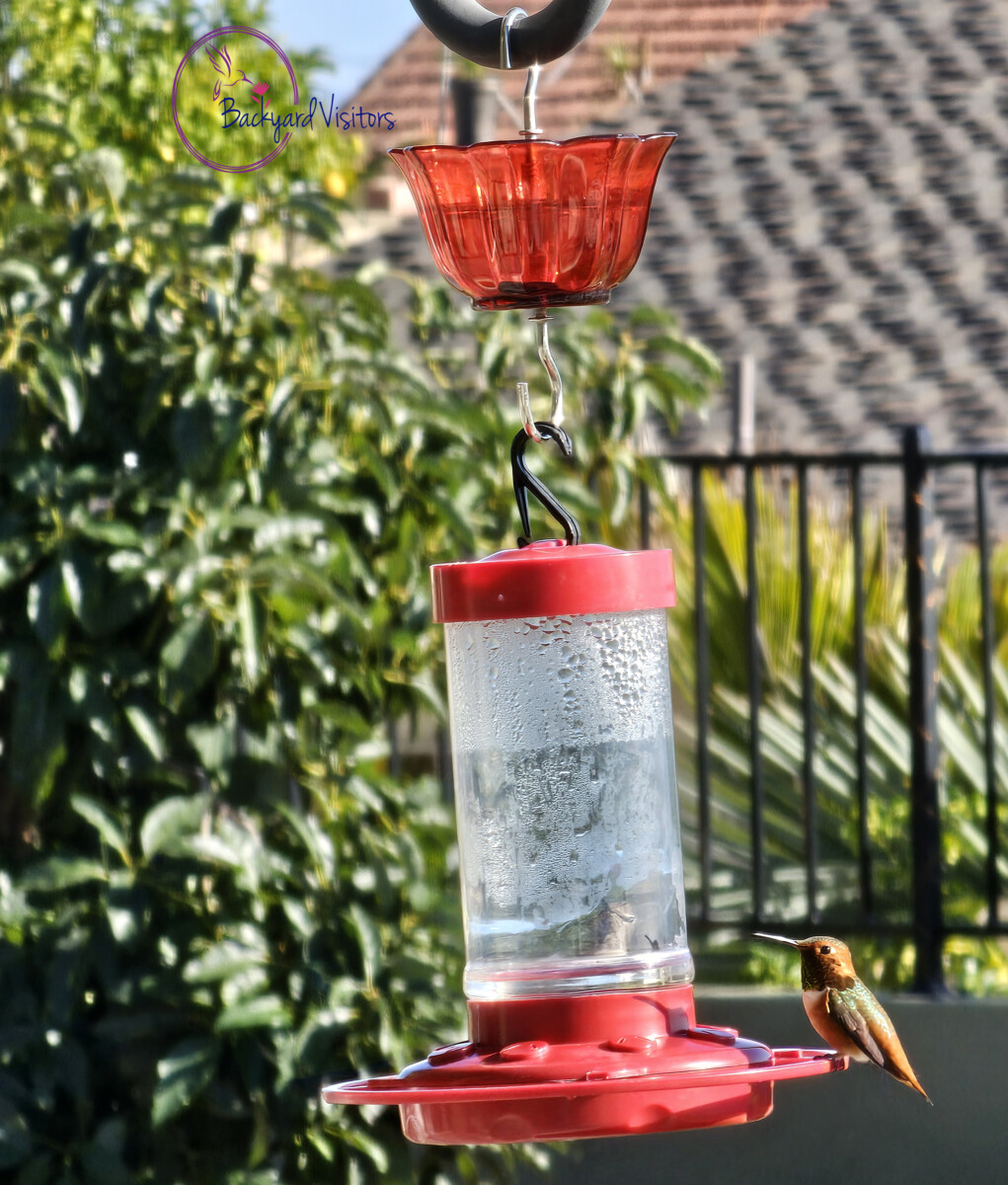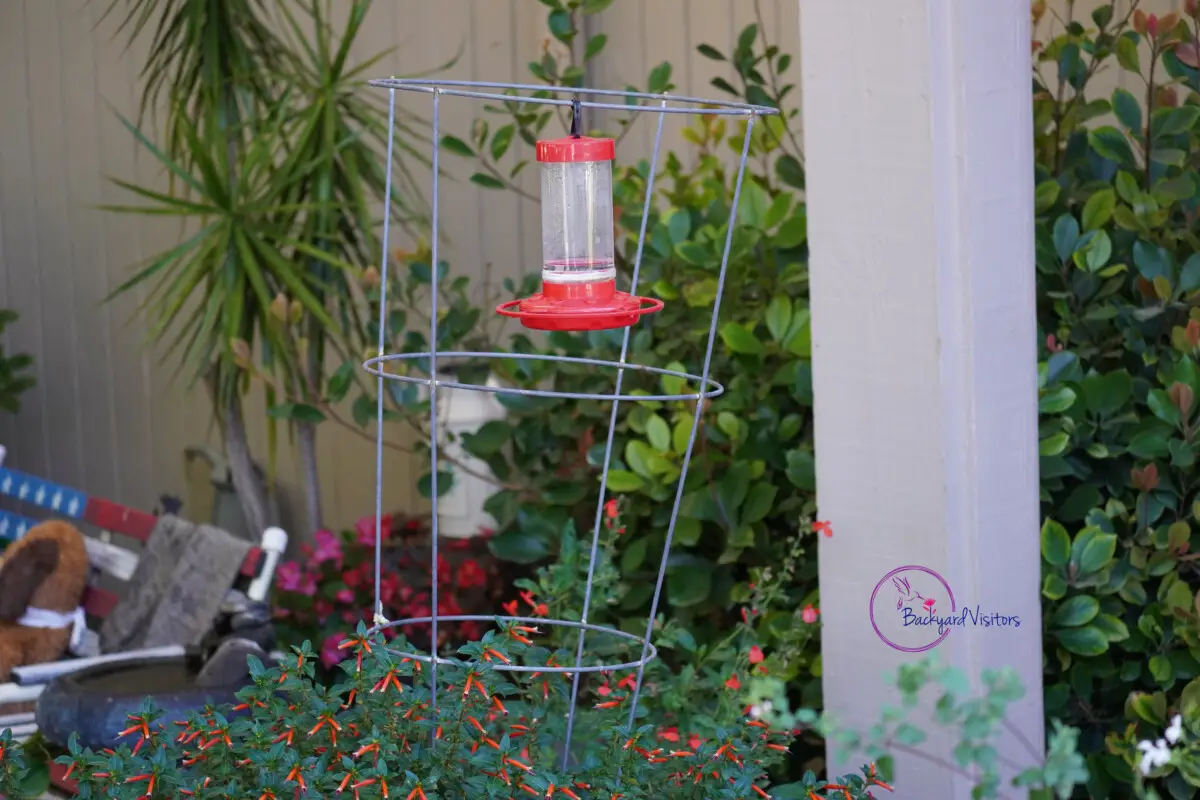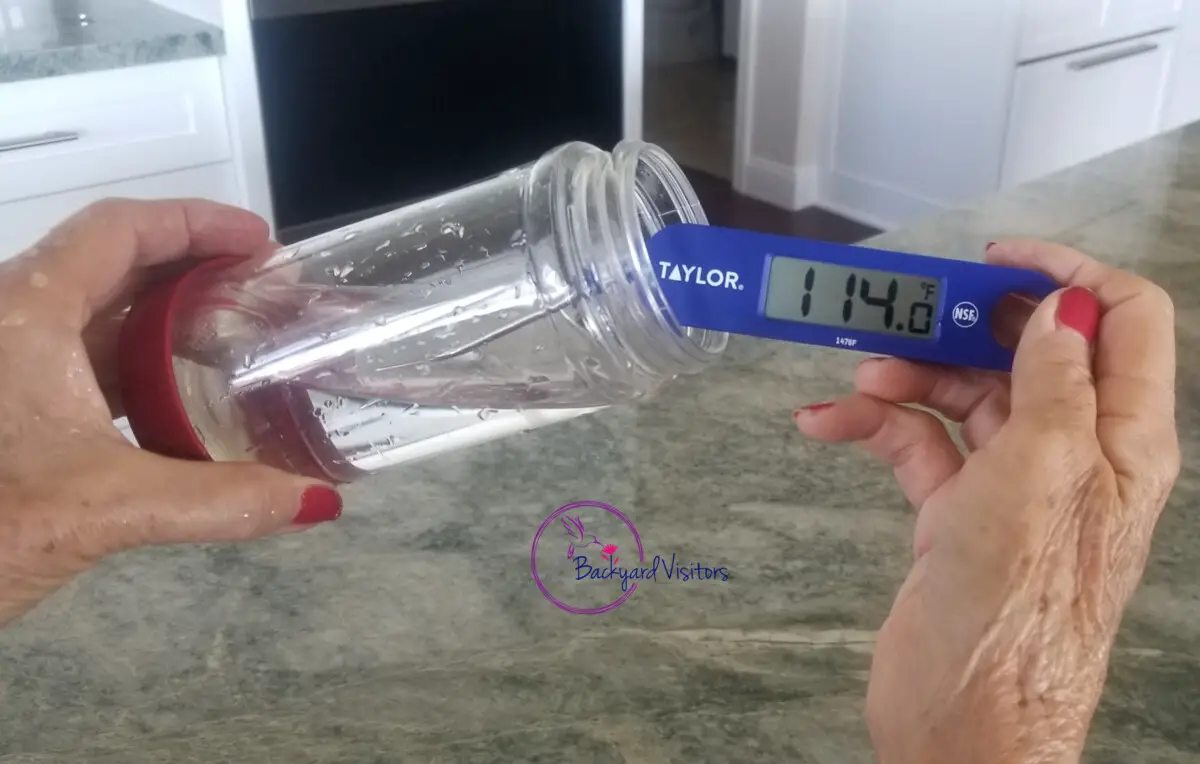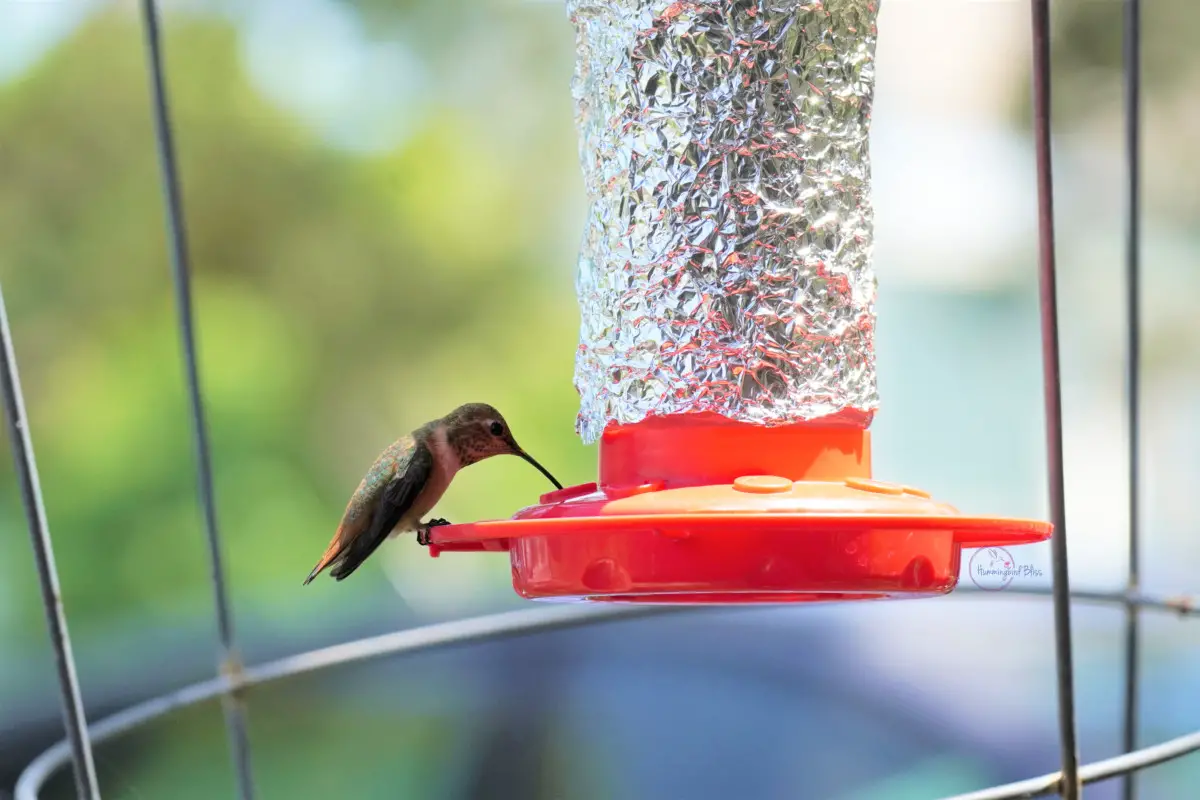This post contains affiliate links.
Optimizing Placement for Hummingbird Feeders: Balancing Sunlight and Shade for Fresh Nectar and Happy Birds
Placing a hummingbird feeder in the sun or shade is based on finding a balance between maintaining the nectar’s freshness and making your bird visitors safe and feel at ease. Sunlight is useful to attract birds’ attention to a feeder from a distance, however, excessive sun exposure quickly ferments the nectar, rendering it harmful for hummingbirds to consume.
The ideal location for your hummingbird feeder is to find a place that receives a mix of daytime sun and shade.
When dawn arrives, the soft warmth from the early morning sun signals the hummingbirds out of torpor and for them to look for nectar to get ready for the day’s journey. If your feeder is placed in the morning sun, the sparkle of the sun’s reflection entices them towards your feeding station. However, as the sun continues to rise, the heat causes the nectar to ferment, therefore moving the feeder to a spot with dappled shade.
If moving the feeder during the day is not an option, then it is imperative to research your yard space on the best location where the feeder is in mixed sun and shade during the day.
Remember that the birds’ well-being and health are paramount, therefore place the feeder in a location that offers morning sun and afternoon shade along with providing a protected area that offers a place for them to rest and eat in peace.
Keeping the hummingbird feeder clean and filled with fresh homemade nectar is essential in maintaining the health of the birds and in turning your backyard into a gathering place for these entertaining guests.
Your garden will become a sanctuary for these jewels of the sky causing them to sing in gratitude as they enjoy the ideal balance of sunlight and shade.
Why Should Hummingbird Feeders Be Hanged in Shade to Maintain Nectar Quality?
Hummingbird feeders that are hanging in the shade are important to preserving the integrity of the sweet nectar. Too much sunlight spoils the nectar and it succumbs to rapid fermentation, potentially endangering our iridescent friends.
If a feeder is protected from direct sunlight, the nectar retains its alluring freshness for a longer period, thus drawing more backyard visitors. Hummingbird feeders that are placed in an area that shields them from direct sunlight reduces the temperature and inhibits the growth of bacteria and mold, which thrive in warmer environments.
Maintaining the quality of the nectar for the health of the hummingbirds is a primary goal. Frequent cleaning along with deliberate positioning that offers protection from the sun’s rays maximizes the condition of the nectar and the welfare of the visiting hummers to make sure our little friends have access to the pure nectar they so truly require and enjoy.
It is advised to strike the ideal balance between soft morning sun and afternoon shade for the feeder.
Position hummingbird feeders in areas that offer shade. A feeder that is shielded from the sun will have nectar that is more appealing and fresh for longer, which draws more backyard visitors. Furthermore, keeping hummingbird feeders out of direct sunlight lowers the temperature and prevents the formation of mold and bacteria from growing.
Should Hummingbird Feeders Be in Sun or Shade for Attracting More Birds?
As an avid hummingbird enthusiast, the question of whether to place a hummingbird feeder in sun or shade for optimal bird attraction is key.
Direct sun spoils the nectar faster, a little sun helps catch the glint that draws hummingbirds in. Feeder placement in dappled sunlight provides the best of both worlds—warmth from the sun without the harsh effects that could degrade the quality of the nectar. It is crucial for the feeder to receive some sun, as hummingbirds are attracted to the light reflecting off the feeder, simulating the natural gleam of flower nectar.

Hummingbird feeders positioned in the shade maintain cooler temperatures, preventing fermentation and bacterial growth. During the intense midday sun it is important to have your feeder in the shade for part of the day.

This balance ensures our feathered visitors enjoy high-quality nectar, and the chances of attracting more birds to your feeder increase. Ultimately, the choice of hanging a feeder in sun or shade also affects the longevity of the feeder itself, with the sun potentially causing damage over time.
It is essential to account for how often the sun hits the spot through the day when considering a feeder location. A feeder in shade during the hottest parts of the day will keep the nectar sweet and desirable for the birds. Whether your feeders are hung in sun or shade, remember that the comfort and health of the birds come first. Strategically placed bird feeders provide a safe and inviting place for birds to congregate and dine.
What are the Pros and Cons of Placing a Hummingbird Feeder in the Sun?
Having your feeder in direct sunlight makes it a glittering beacon for hummingbirds. The sun’s rays highlight the feeder’s colorful design and nectar, thereby attracting the iridescent creatures more effectively.
However, having a hummingbird feeder basking under the sun is not without its setbacks. Nectar can quickly ferment in the heat, making it less palatable and potentially harmful to our humming friends. It is crucial that the feeder is checked and cleaned more frequently to ensure the quality of the nectar is not compromised.

It was only 82 degrees outside!
On the flip side, shade plays a nurturing role in preserving the nectar’s freshness and extending the food’s longevity. A feeder nestled in a shady area may not initially capture a hummingbird’s attention as readily as one in the sunshine, but it will offer a much cooler, safer dining location once it is discovered.
Hummingbird feeders under the canopy of trees may entice fewer hummingbirds initially, those who visit will enjoy a more wholesome meal. Thus, your feeder’s location should strike a balanced harmony between visibility and the conservation of the nectar’s quality. Proximity to flowers and plants that naturally attract hummingbirds can counterbalance the shade’s subtle concealment.
Ultimately, positioning your hummingbird feeder in the sun requires deliberate thought on how it will affect both the allure to hummingbirds and the maintenance of the nectar. This delicate dance of feeder placement is essential for the hummingbirds’ welfare and the observers’ delight.
How to Shade Your Hummingbird Feeder: Tips for Keeping the Nectar Cool
Ensuring that your hummingbird feeder is thoughtfully placed in your yard to maintain the integrity of the sweet nectar is a hummingbird enthusiast’s top priority.
Adopting tips for feeder placement can significantly enhance your bird watching experience. A hummingbird feeder should be accessible yet not fully exposed to relentless daylight, invoking an approach that ensures feeders receive filtered light or partial shade throughout the day.
A feeder that is provided with shade will shield the sugar nectar solution from the harsh effects of direct sunlight, which causes fermentation and spoilage. Keeping the feeder away from the direct sun helps prolong the nectar’s freshness, requiring less frequent cleaning and refilling.
When placing your feeder, consider areas that deliver morning sun and afternoon shade, offering the best compromise to attract hummingbirds while preserving the nectar.
You can create an oasis with artificial structures that provide shade, ensuring your sugar nectar solution remains cool and inviting for your aerial guests.
See my article: How to Cool Hummingbird Nectar in Hot Weather

Remember, the goal is not to expose the sweet nectar to the elements that quickly increase fermentation but to provide a balance for these backyard visitors to thrive and be given protection from the extremes.
Hummingbird feeders are best when given protection from the extremes. With these essential tips on placing hummingbird feeders in an agreed spot that provides shade and keeps the nectar tempting for these jewel-toned flyers, you will foster a buzzing hub of activity in your slice of paradise.
Why Does the Placement of a Hummingbird Feeder Matter for Bird Safety?
When considering whether a hummingbird feeder should bask in the sun or be nestled in the shade, it is vital to prioritize the birds’ safety. Should hummingbird feeders soak in the sun, where birds can bask in its warmth? Or should hummingbird feeders snuggle in the shade, providing a cool refuge for our feathered friends?
The placement of hummingbird feeders has a profound impact on the well-being of birds.
A hummingbird feeder in full sun quickly becomes a hotspot, not just for birds seeking nectar but also for the nectar itself to spoil. With more sun, feeders harbor fermented, unhealthy nectar that harms birds.
Conversely, should hummingbird feeders be placed in the shade as they remain a welcoming haven for birds. Shade ensures the nectar within feeders retains its freshness, warding off the rapid growth of bacteria and yeast that taint the quality of this vital food source. While many birds enjoy basking in the gentle rays, when it comes to feeders, they inherently seek out reliable, safe food sources, which are often found in the shade.
Feeders in the right balance of sunlight and shade make for happy birds, promising a freshly maintained supply of nectar. Shaded feeders encourage more birds to visit, turning your backyard into a bustling hub for these exquisite creatures. Recognizing the delicate balance between the pros and cons of placing a hummingbird feeder in the sun or the sheltering arms of a tree, one can optimize the placement for both safety and pleasure.
Consequently, to keep nectar cool and birds safe, shading your hummingbird feeder—with thoughtful consideration of sun exposure—is a wise choice that every backyard visitor deserves.
Does a Shady Location Protect Hummingbird Feeders from Wind and Storms?
Hummingbird enthusiasts frequently wonder if their feathered companions benefit more from positioning hummingbird feeders in the shade. Does it protect the hummingbird feeders from wind and storms in addition to preserving the quality of the nectar?
Strong gusts can cause feeders to sway or even become damaged. A well-chosen spot with a canopy of leaves or near structures that provide shade are less exposed to strong winds. Feeders hung under shaded areas guarantees that the nectar stays fresh and serves as a natural shield against inclement weather.
Feeders that are in the sunlight entice more hummingbirds due to the glint of light on the nectar or the color of the bottle. However, these same placements are prone to higher wear and tear from sun exposure and the wind. The delicacy of hummingbird feeders demands consideration of their location, beyond just the visual appeal.
Proper placement of feeders in a place that provides shade prevents them from toppling during storms. This protective measure not only extends the lifespan of the feeders but also ensures the safety of the birds we aim to attract.
Place your hummingbird feeders in an area that provides shade as this ensures that your feeders are safeguarded from wind, and the unpredictability of storms. The prime place for a feeder is where it balances accessibility for the birds with protection from the elements, ensuring a tranquil spot for your hummingbird friends to dine away from the wind and the tumultuous outcomes of storms.
How Many Bird Feeders Should You Hang for Optimal Hummingbird Attraction?
When hanging hummingbird feeders, the question is not just whether the feeder should be in sun or shade, but also how many feeders are ideal for attracting these vibrant birds. Hummingbird enthusiasts have learned that multiple feeders creates a lively haven for birds while reducing territorial disputes among hummingbirds.
Consider the size of your space and how to provide various feeding zones. For a small garden, a couple of feeders will suffice, but if you have a larger area, hang several spaced out feeders to ensure the birds have their own dining locations.
If the goal is to maximize hummingbird visits, do not cluster all your feeders in one location; instead, disperse them throughout your yard. This prevents any single bird from dominating all feeders and allows shy birds a chance to feed.
Additionally, keep in mind that hummingbird feeder placement involves not only the number of feeders but also their exposure to the elements. While each feeder is hung in a position to offer a balance between sun and shade, it is crucial that each spot protects the nectar within from becoming too hot, which causes it to spoil more rapidly.
Thoughtful placement also means considering how the feeders will fare during harsh weather. Placing a feeder in a spot that is too exposed may lead to damage from wind or storms. Adding more feeders to your backyard with prioritized sheltered locations that offer protection while not fully denying the birds the pleasure of basking in the gentle sun is important. By taking these factors into account, your feeders will not only be a welcoming sight for the birds but also a picturesque addition to your backyard sanctuary.
For more information about hummingbirds, read my other hummingbird articles.
Happy Hummingbird Watching!
Backyard Visitors participates in affiliate programs which compensate us for referring traffic.

